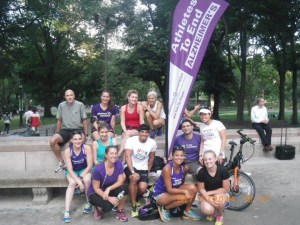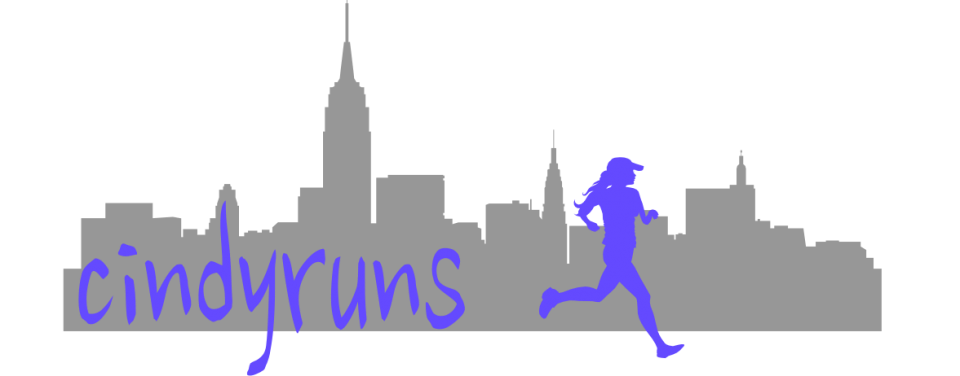I used to joke about how distance running was a “selfish sport” which is probably why so many runners run for a charity team. I have a feeling I just opened a can of worms but please hear me out. I am one of those charity runners and I can’t imagine it any other way.
Sure when you go out for a long run solo, it feels selfish. You’re taking hours away from family and friends to spend by yourself running. The benefits that you reap from the long run only affects you, right? No, that’s where it’s completely wrong. No matter why you chose to go on that long run, whether it was to clear your head, maintain physical fitness, or training for a race, the endorphins that you feel afterwards will benefit more than just yourself. I come home from runs on a high. The days I don’t get my run or exercise in, Josh notices my crankiness! No matter why you out for a run, it brings you back a better person for everyone around you and for that, it’s not a “selfish sport.”
Last week I was asked to speak at the fundraising panel for our marathon team and as I was thinking about what to say, I came across this interesting statistic about how Americans love running for a cause and in 2012, over $1.68B was raised through charity races (source: http://blog.nordictrack.com/nordictrack/?p=2798 via The Hungry Runner Girl). I wonder if this includes all the money that is raised by charity teams for marathons?!?! I imagine the NYC Marathon is up there with all the charity teams out there.
As most know my story already, but I started out as a sprinter in high school and college and then an occasional 5K here and there after college turned into a passion for distance running when I joined the Athletes to End Alzheimer’s team for the 2012 NYC Marathon. I joined the team to help raise awareness for Alzheimer’s and to do something in memory of my grandmother who suffered and passed away from the disease. Running has made me a much stronger person and helped me find perspective and prioritize the important things in life. I run for myself, but I also run for my family, friends, my teammates, everyone who has been touched by Alzheimer’s disease at some point in their life, and to help find cure for the disease.

Some of the 2014 Athletes to End Alzheimer’s NYC Marathon team with Josh helping with bag drop that evening!
I am a runner, but more importantly I am a charity runner and I am darn proud of it. Though I have guaranteed entry into the NYC Marathon, I still run for and with the Athletes to End Alzheimer’s team. Every time I have a hard run, I remind myself why I am running and think of my grandma. I started blogging when I started training for the 2012 NYC Marathon to share memories of my grandmother and to share my training progress. Over the last couple of years, I fundraised over $7,000 for the Alzheimer’s Association, NYC Chapter and still going! I learned a lot about some of the things that really work for me when fundraising. Here are some of my thoughts in no particular order:
- –Share your story. You don’t have to over share, I totally understand that some things are just too personal but sharing helps explain why you’re doing what you’re doing. You don’t have to share with words if you don’t want to. Pictures help, a lot! For the 2012 NYC Marathon, I included a picture a week of my grandma in my blog posts. The blog ended up being a great journal for myself to remember the incredible journey.
- –Using social media. I shared my donation page and blog through social media – Twitter and Facebook. Even if you don’t receive any specific donations from strangers, it helps raise awareness for the cause. For me, I’ve been fortunate to have received donations from friends that I haven’t talked to in years through this approach.
- –Contacting family and friends. I am not a big fan of soliciting friends and family. I don’t want people to feel like they have to donate to me, I want them to want to donate to the cause. Instead of sending direct emails or letters, I opted for mass emails. For some reason, I felt like the less personal approach gave people an out if they wanted to. I know that not everyone agrees with that approach, but it seemed to work better for me. I know others who prefer to send a personal note and that seems to work really as well, so it’s really a matter of what you’re comfortable with.
- –Add some kind of personal touch. While I may not send direct personal notes when fundraising, I always sent a handwritten thank you note to everyone who donates. I really appreciate donations of any size and for that I am grateful and I wanted to make sure that anyone who donates knows how I feel. If you like receiving mail on pretty note cards, you should donate (kidding, well half kidding!).
- –Sharing the journey. I realize that not everyone wants to stay up to date on what I do all the time but in case they were interested, I wanted to make sure there was a way for people to see how I was doing with fundraising, running, or just in general. That is where my blog comes in to play. I always share it in my notes and even if someone cannot donate, I appreciate the virtual support.
- –Free money (corporate matching). This is the easiest part of fundraising. Make sure your friends and family know that their companies may participate in matching gifts for certain tax-deductible donations. You can search for whether or not your company matches on many different websites or by checking out the company’s HR or corporate benefits site.
What are some other fundraising tactics that have worked well for you? Happy to learn about other ways to help raise awareness for Alzheimer’s!
And P.S. if you’re interested in donating to the Alzheimer’s Association, NYC Chapter, please visit my donation page. I appreciate any and all support!








